I got some more animal suggestions... I still do not think WEO's north america is as realisticly diverse as it should be.
my ideas
Turkey vulture
If you’ve gone looking for raptors on a clear day, your heart has probably leaped at the sight of a large, soaring bird in the distance– perhaps an eagle or osprey. But if it's soaring with its wings raised in a V and making wobbly circles, it's likely a Turkey Vulture. These birds ride thermals in the sky and use their keen sense of smell to find fresh carcasses. They are a consummate scavenger, cleaning up the countryside one bite of their sharply hooked bill at a time, and never mussing a feather on their bald heads.
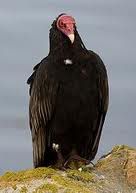
yellow headed blackbird
Its brilliant yellow head, together with its loud, rusty-hinge call, make the Yellow-headed Blackbird a conspicuous presence in western wetlands. It breeds in loose colonies and places its nest over water, attached to cattails and reeds.
Food
Aquatic insects, grain, and weed seeds.
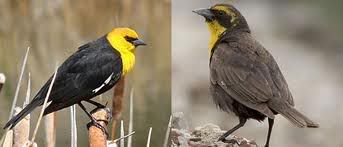
aquatic insects
An added peice to the insects we have now. It Would work well with the yellow headed blackbird.
lazuli bunting
similer to the eastern bluebird.
A beautifully colored bird, the Lazuli Bunting is common in shrubby areas throughout the American West
habitat
Open Woodland
Bushy hillsides, riparian habitats, wooded valleys, sagebrush, chaparral, open scrub, recent post-fire habitats, thickets and hedges along agricultural fields, and residential gardens.
Nest Description
Open cup of coarse grasses, rootlets, strips of bark, and leaves, lined with fine grass, rootlets, and animal hairs. Wrapped in silk. Placed in shrub, close to ground.
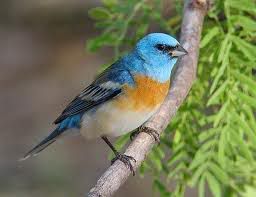
American Kestrel
A smaller and more colorfull version of the current redtail hawk with a slightly different diet.
North America’s littlest falcon, the American Kestrel packs a predator’s fierce intensity into its small body. It's one of the most colorful of all raptors: the male’s slate-blue head and wings contrast elegantly with his rusty-red back and tail; the female has the same warm reddish on her wings, back, and tail. Hunting for insects and other small prey in open territory, kestrels perch on wires or poles, or hover facing into the wind, flapping and adjusting their long tails to stay in place. Kestrels are declining in parts of their range.
American Kestrels eat mostly insects and other invertebrates, as well as small rodents and birds. Common foods include grasshoppers, cicadas, beetles, and dragonflies; scorpions and spiders; butterflies and moths; voles, mice, shrews, bats, and small songbirds. American Kestrels also sometimes eat small snakes, lizards, and frogs. And some people have reported seeing American Kestrels take larger prey, including red squirrels and Northern Flickers.
American Kestrels do not use nesting materials. If the cavity floor is composed of loose material, the female hollows out a shallow depression there.
American Kestrels nest in cavities, although they lack the ability to excavate their own. They rely on old woodpecker holes, natural tree hollows, rock crevices, and nooks in buildings and other human-built structures. The male searches for possible nest cavities. When he’s found suitable candidates, he shows them to the female, who makes the final choice. Typically, nest sites are in trees along wood edges or in the middle of open ground.
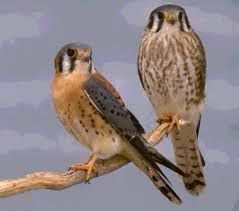
Great blue herons
The familiar Great Blue Heron is the largest heron in North America. It is a large bird, with a slate-gray body, chestnut and black accents, and very long legs and neck. In flight, it looks enormous, with a six-foot wingspan. Adults sport a shaggy ruff at the base of their necks. A black eyebrow extends back to black plumes emerging from the head. Juveniles have a dark crown with no plumes or ruff, and a mottled neck. In flight, a Great Blue Heron typically holds its head in toward its body with its neck bent.
Habitat
Adaptable and widespread, the Great Blue Heron is found in a wide variety of habitats. When feeding, it is usually seen in slow-moving or calm salt, fresh, or brackish water. Great Blue Herons inhabit sheltered, shallow bays and inlets, sloughs, marshes, wet meadows, shores of lakes, and rivers. Nesting colonies are typically found in mature forests, on islands, or near mudflats, and do best when they are free of human disturbance and have foraging areas close by.
Diet
The variable diet of Great Blue Herons allows them to exploit a variety of habitats. This adaptability also enables them to winter farther north than most herons. Fish, amphibians, reptiles, invertebrates, small mammals, and even other birds are all potential prey of the Great Blue Heron. In Washington, much of their winter hunting is on land, with voles making up a major portion of their winter diet.
Nesting
Great Blue Herons usually breed in colonies containing a few to several hundred pairs. Isolated pair-breeding is rare. Nest building begins in February when a male chooses a nesting territory and displays to attract a female. The nest is usually situated high up in a tree. The male gathers sticks for the female who fashions them into a platform nest lined with small twigs, bark strips, and conifer needles. Both parents incubate the 3-5 eggs for 25-29 days. Both parents regurgitate food for the young. The young can first fly at about 60 days old, although they continue to return to the nest and are fed by the adults for another few weeks. Pair bonds only last for the nesting season, and adults form new bonds each year.
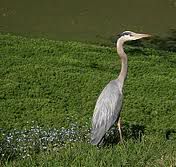
thats all my suggustions for now...






